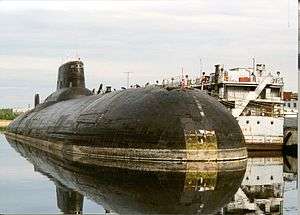Soviet submarine TK-202
ТК-202 was a ballistic missile submarine of the Russian Navy, formerly having served in the Soviet Navy.
 TK-202 in 1999 before recycling/scrapping | |
| History | |
|---|---|
| Name: | TК-202 |
| Laid down: | 1 October 1980 |
| Launched: | 26 April 1982 |
| Commissioned: | 28 December 1983 |
| Decommissioned: | 1997 |
| Fate: | Scrapped |
| General characteristics | |
| Class and type: | Typhoon class submarine |
| Displacement: | |
| Length: | 175 m (574 ft 2 in) |
| Beam: | 23 m (75 ft 6 in) |
| Draught: | 12 m (39 ft 4 in) |
| Propulsion: |
|
| Speed: |
|
| Endurance: | 120+ days submerged[1] |
| Test depth: | 400 m (1,300 ft) |
| Complement: | 160 persons[1] |
| Armament: | |
Hull number TК-202 was laid down at the Sevmash shipyards in Severodvinsk in October 1980 and launched in April 1982. She was the second ship of the Soviet Project 941 Akula class (Russian for shark, NATO reporting name Typhoon). In December 1983, she began her commission in the Soviet Northern Fleet. She was, along with the other Akulas, based in Nerpichya Bay, Zapadnaya Litsa.
During her service in the Soviet era it had a name, but it was forgotten. Several of her sister ships later received names, but the TК-202 and the TК-13 continued to be called by their hull numbers alone. ТК stands for тяжелая крейсерская (tyazholaya kreyserskaya), meaning heavy cruiser.
The 14-year-old submarine was deactivated in 1997, and was laid up from July 1999 at the Sevmash shipyard in Severodvinsk awaiting decommissioning. With funding from the Nunn–Lugar Cooperative Threat Reduction programme the defueling of her reactors started in June 2002 at the Zvezdochka shipyard.
It was scrapped between 2003 and 2005.
Sources
- deepstorm.ru - TK-202 (in Russian)
References
- Podvodnye Lodki, Yu.V. Apalkov, Sankt Peterburg, 2002, ISBN 5-8172-0069-4
- Only 20 torpedoes and/or AShMs can be loaded.